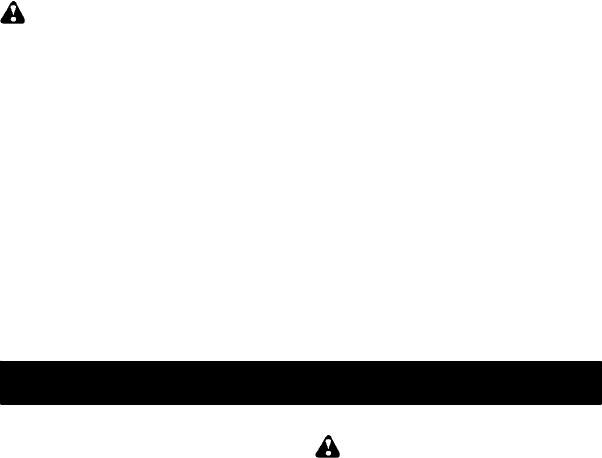
8
BEFORE STARTING SAW
WARNING: Be sure to read the
electrical safety information in the
SAFE-
TY RULES section of this manual before
you begin. If you do not understand the
electrical safety information do not a t-
tempt to use your unit. Seek help from
someone that does understand the in-
formation or call the customer assis-
tance help line at 1-800-554-6723.
GUIDE BAR AND CHAIN OIL
The barand chain r equir elubricati on. The
manually--operat ed chain oi l er provides
lubri cati on to the chain and guide bar. Be
sur e to fi ll the bar oil tan k bef ore each cut-
ti n g session. The oi ler acti vator/ baroilcap
must be used regularl y and of t en enough
to maintain a thin f i l m of oil on the bar and
chain while saw is cutting. It i s r e com-
mended t hat the oiler actuat or / bar oil cap
be oper a ted every t e n (10) seconds and
held for approxim atel y thr ee (3) seconds
each ti me it is pr esse d. For maxim um
gui de b ar and chai n life, we recommend
you use Poulan chain saw bar oil. I f Pou-
lan bar oil is not avail abl e, you may use a
good gr ade SAE 30 oil until you are able
to obtain Poulan br and. The oil output i s
manually metered duri ng operat ion. Use
a funnelto fil lthe tank. Replace oil cap se-
curely . Check oil level after every 15 min-
utes of operat ion.
STOPPING YOUR SAW
S Release the trigger switch.
S If motor does not stop, disconnect the
extension cord. Discontinue use of
the unituntilrepaired by anauthorized
service dealer.
STARTING YOUR SAW
1. Connect the saw to a power source
using the proper size extensioncord
(see
SELECT AN EXTENSION CORD).
2. Push in switch lock out button.
3. Squeezeand hold the triggerswitch.
CUTTING METHODS
OPERATING TIPS
S Check chain tension before first use
and after 1 minute of operation. See
CHECKCHAIN TENSION in the MAINTE-
NANCE
section.
S Cut wood only.Do not cut metal, plas-
tics, masonry, non-wood building ma-
terials, etc.
S Stop the s aw if the chain strikes a for-
eignobject.Inspectthesa w andrepair
parts as necess ary.
S Keep the chain out of dirt and sand.
Even a small amountof dirtwillquickly
dull a chain and increase the possibil-
ity of kickback.
S Practice cuttinga few small logs using
the following steps. This will help you
get the “feel” of using your saw before
you begin a major sawing operation.
S Squeeze the t ri gge r swit c h and all o w
unit to reach ful l speed befor e cutt ing.
S Begin cutting with the s aw frame
against the log.
S Keep the motor at full speed the en-
tire time you are cutting.
S Release trigger switch as soon as cut
is completed, allowing motor to stop.
S Keep thecord away from the cutting
area. Position cord so it will not be
caught on branches and the like
during cutting.
S To avoid losing control when cut is
complete, do not put pressure on
saw at end of cut.
S Stop motor before setting saw down.
TREE FELLING TE CHNIQUES
WARNING: Check for broken or
dead branches which can f al lwhile cutt i ng
causing seri ous inj ury. Do not cut near
buildi ngs or electr i cal wir es if you do not
know the d i rect i on of tree fall , nor cut at
night since you will notbe able to see well,
nor during bad weather such as rain,
snow,strongwinds,etc.Ifthetreemakes
contact with any utility line, the utility com-
plany should be noti f i ed immediately.
S Caref ull y plan your sawing operat i on in
advance.
S Clear the work area. Yo u need a clear
area allaround the t r eeso you can have
secure foo t ing.
S The chain saw operator should keep
on the uphill side of the terrain as the
tree is likely to roll or slide downhill af-
ter it is felled.
S Study the natural condit i ons that can
cause the tree to fall in a particular direc-
tion, such as:
S The wind direction and speed.
S The lean ofthe tr ee.The lean of a tr ee
mig ht not be appar e nt due t o uneven
or sl oping terrai n . U se a plumb or lev-
el to det er mi ne the d i r ecti on of tree
lean.
S Weight and branches on one side.
S Surrounding trees and obstacles.
S Look for decay and rot. If the trunk is
rotted, it can snap and fall toward the
operator.


















